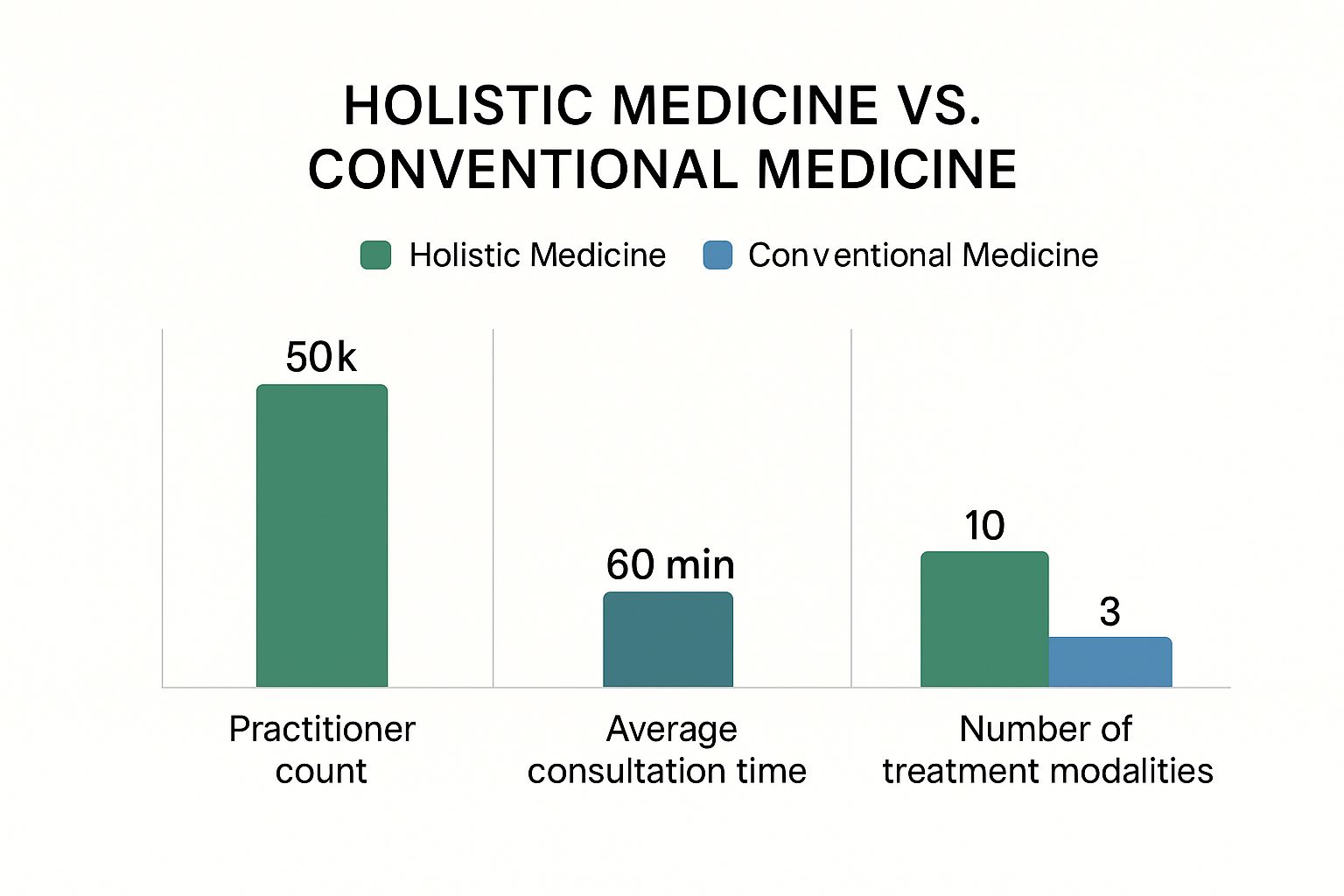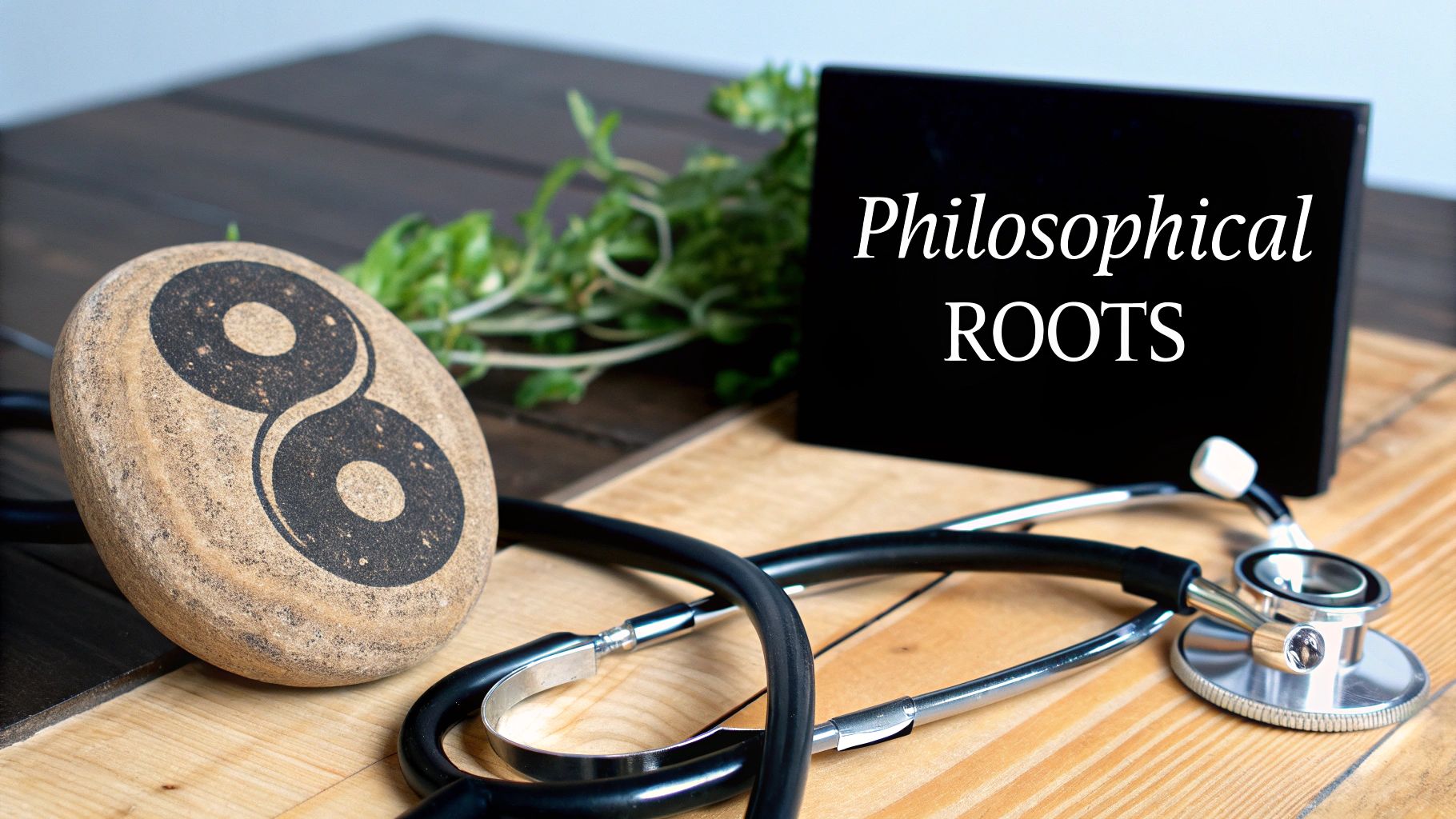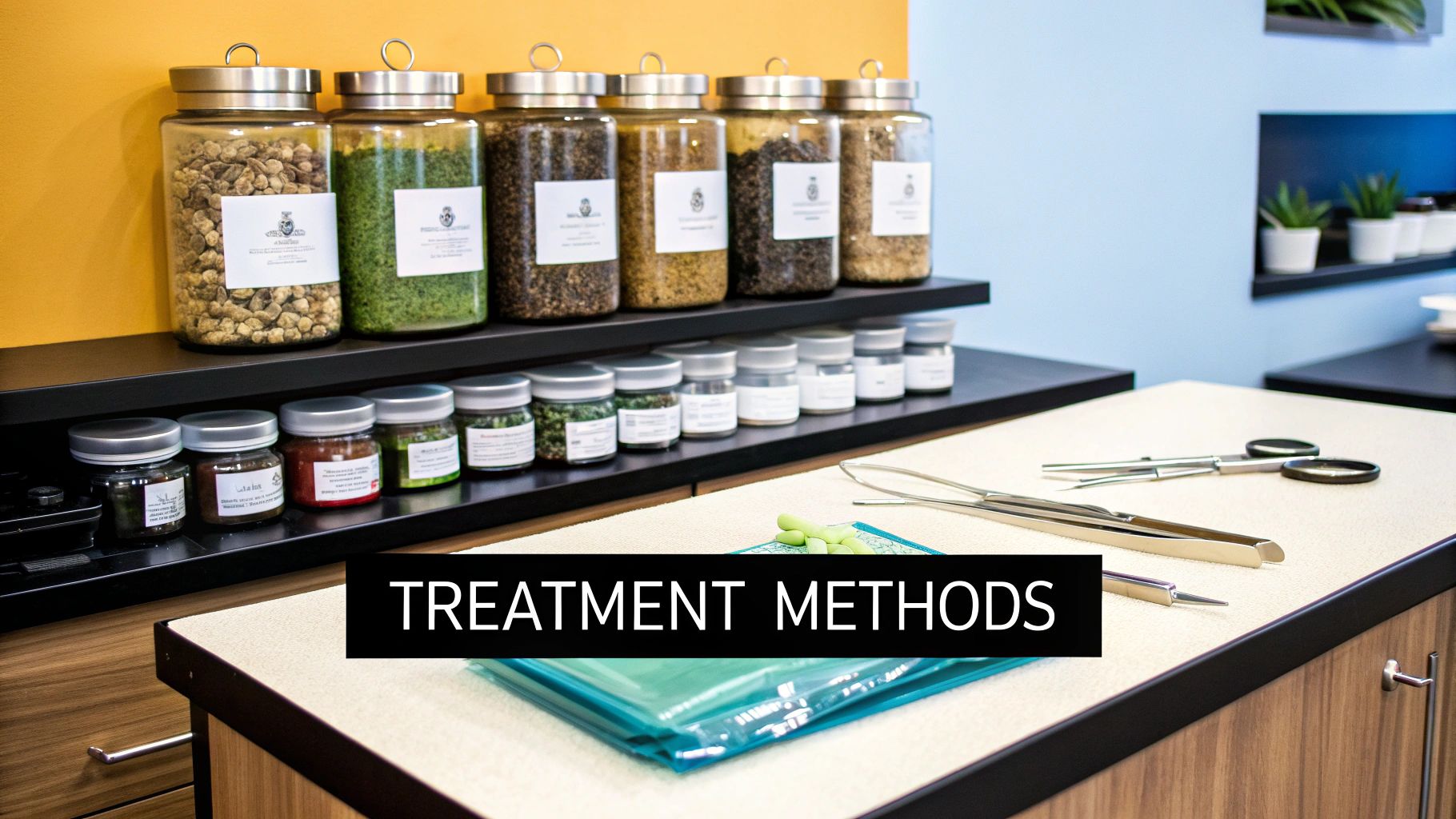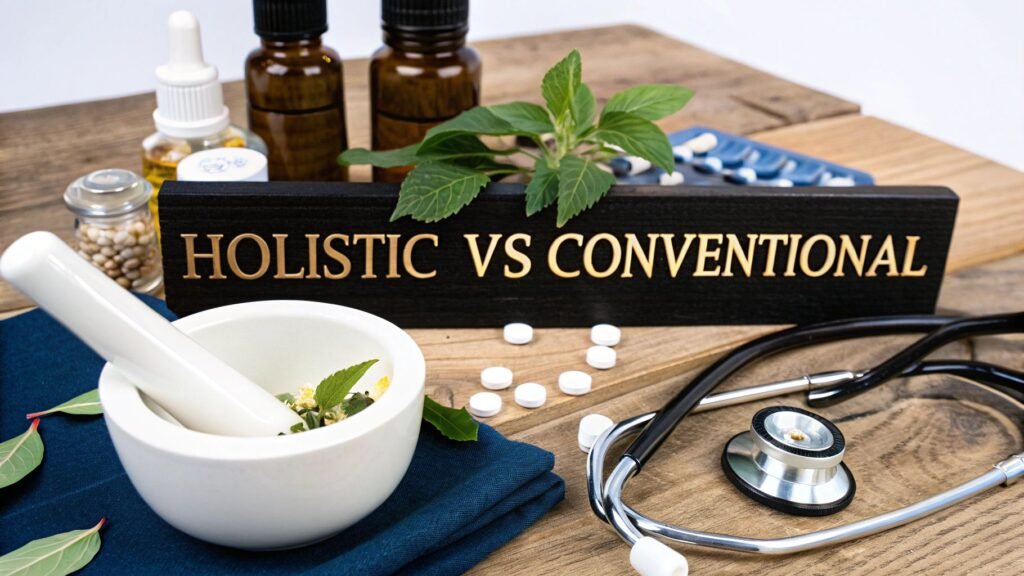The core difference between holistic and conventional medicine really comes down to focus. Holistic medicine is all about treating the whole person—mind, body, and spirit included—while conventional medicine zeroes in on specific symptoms and diseases. The right path for you often depends on whether you're looking to get to the root cause of an imbalance or need urgent, targeted treatment for an acute problem.
Defining Two Core Philosophies of Care
To really understand the debate of holistic medicine versus conventional medicine, you have to start with their foundational principles. These aren't necessarily opposing forces locked in a battle, but rather two distinct ways of looking at health, each with unique strengths for different situations.
Conventional medicine, which you might also hear called allopathic or Western medicine, is built on a disease-centric model. It’s incredibly effective at identifying and treating specific illnesses or injuries using proven methods like pharmaceuticals, surgery, and radiation. The primary goal is almost always to manage or get rid of the symptoms tied to a specific diagnosis.
On the other hand, holistic medicine sees the body as a completely interconnected system. From this perspective, your emotional, mental, spiritual, and physical health are all woven together. An illness isn't just a random event; it's often a sign of a much deeper imbalance within you. Holistic practitioners work to support the body’s natural ability to heal and bring back that overall sense of wellness. This might involve a wide spectrum of therapies, including ancient practices like Traditional Chinese Medicine. You can find a deeper exploration of this in our guide on what is Traditional Chinese Medicine.
The perspective is the real differentiator. Conventional medicine asks, "What disease is causing this person's symptoms?" In contrast, holistic medicine asks, "Why has this person's system created an environment for this imbalance to develop?"
Fundamental Differences in Medical Approaches
To get a clearer picture of these philosophies in action, it helps to see them side-by-side. The table below breaks down their core components.
| Aspect | Conventional Medicine | Holistic Medicine |
|---|---|---|
| Guiding Philosophy | Focuses on treating specific diseases and symptoms. | Focuses on treating the whole person (body, mind, spirit). |
| Diagnostic Focus | Utilizes lab tests, imaging, and physical exams to identify pathogens or physiological abnormalities. | Utilizes in-depth patient interviews, lifestyle assessments, and observation to identify systemic imbalances. |
| Treatment Approach | Employs targeted interventions like pharmaceuticals, surgery, and radiation. | Employs a broad range of therapies, including nutrition, herbal remedies, acupuncture, and lifestyle changes. |
This comparison highlights the fundamental split in how each practice approaches patient care, from initial diagnosis to the final treatment plan.

As the numbers show, conventional medicine has a much larger workforce. However, the significantly longer consultation times in holistic care point to its emphasis on understanding the patient's entire life context, not just their immediate physical symptoms.
Comparing Diagnostic and Treatment Philosophies

When you dig into the holistic vs. conventional medicine debate, the most profound difference isn't just the treatments—it's how each philosophy approaches the very concept of illness. At their core, they have fundamentally different ways of asking "What's wrong?" and "How do we fix it?" One is a detective, isolating a culprit; the other is a cartographer, mapping the entire landscape where the problem arose.
Conventional medicine is built on a reductionist model. Think of it as breaking down a complex machine into its smallest components to find the single faulty part. The diagnostic process is a focused investigation to pinpoint a specific pathogen, a biochemical imbalance, or a structural flaw that’s causing the symptoms. It’s methodical, precise, and evidence-driven.
Let’s say you’re dealing with persistent fatigue. A conventional doctor will likely order a series of lab tests—blood counts, thyroid function, vitamin levels. This data-driven approach is designed to find a clear, identifiable cause that can be directly addressed with a targeted treatment, like thyroid medication or iron supplements.
The Conventional Approach To Diagnosis
Modern medicine’s strength lies in its reliance on objective, measurable data. Advances have even brought this power into our homes through options like at-home health testing, giving us proactive insights. This diagnostic toolkit is incredibly effective for identifying acute and specific conditions.
Key diagnostic tools include:
- Laboratory Tests: Blood work, urinalysis, and genetic testing give us a clear snapshot of the body's internal chemistry.
- Imaging Technology: X-rays, CT scans, and MRIs allow physicians to see inside the body to spot structural issues like tumors or fractures.
- Clinical Trials: These remain the gold standard for proving that new drugs and procedures are both safe and effective, ensuring treatments are backed by solid scientific evidence.
This focus on verifiable data is why conventional medicine excels in emergencies, with infectious diseases, and for conditions that need surgery. The treatment philosophy is direct: prescribe a drug to fix a chemical imbalance or perform surgery to repair a physical problem.
The Holistic Viewpoint On Health
In sharp contrast, holistic medicine approaches diagnosis from a perspective of interconnectedness. Here, illness isn't seen as an isolated event. It’s a symptom of a much larger imbalance within the person’s entire system—physically, mentally, emotionally, and even environmentally. The goal isn't just to find a single cause but to understand the whole story.
A holistic practitioner, faced with that same complaint of fatigue, would start with an in-depth conversation. This discussion would go far beyond physical symptoms, exploring your diet, sleep patterns, stress levels, emotional state, and relationships. They see these elements as crucial pieces of the health puzzle.
"A holistic diagnosis seeks to understand the 'why' behind the 'what.' It's not just about identifying the disease; it's about uncovering the conditions that allowed the disharmony to arise in the first place."
This comprehensive view is gaining serious traction. The World Health Organization (WHO) has underscored the importance of integrating traditional and complementary medicine into national healthcare systems. This reflects a growing global understanding of their value in managing chronic conditions and promoting true wellness.
Contrasting Diagnostic Techniques
Naturally, the tools used in holistic diagnosis are different, focusing on qualitative information and the body's subtle cues. A practitioner might use techniques like tongue and pulse diagnosis to assess the body’s internal state, a method that can reveal patterns of imbalance completely invisible to a standard blood test. You can dive deeper into the nuances of Chinese medicine pulse diagnosis to see how it works.
The treatment plan that emerges from this process is equally distinct. Instead of targeting the fatigue itself, a holistic plan might weave together several strategies:
- Dietary changes to correct nutritional gaps.
- Herbal remedies to support adrenal function.
- Acupuncture to restore the body's energy flow.
- Mindfulness practices to better manage stress.
The entire approach is designed to gently guide the system back into balance, working from the belief that when harmony is restored, the symptoms will resolve on their own.
An In-Depth Look at Treatment Modalities

The philosophical split between holistic and conventional medicine really comes into focus when you look at their treatment toolkits. Both disciplines want to restore health, but their methods—their modalities—are born from very different ideas about what causes illness.
Conventional medicine is about precision and power, zeroing in on a specific problem. Holistic medicine, on the other hand, pulls from a much broader set of therapies to gently nudge the entire system back into balance.
Conventional Medicine's Targeted Interventions
The real strength of conventional medicine is its ability to intervene with incredible accuracy and force. This makes it absolutely essential for medical emergencies and life-threatening diseases. The main treatment modalities are backed by extensive research, highly standardized, and designed to produce predictable results by acting on a specific physiological target.
These core treatments include:
- Pharmaceuticals: Prescription drugs are the foundation of modern medical care. They're engineered to alter very specific biochemical pathways. For example, an antibiotic is built to kill a particular strain of bacteria, while blood pressure medication works on the mechanisms controlling vascular constriction.
- Surgery: When a physical problem needs a direct fix—like removing a tumor, setting a broken bone, or replacing a faulty heart valve—surgery is the answer. It is a direct, mechanical intervention.
- Radiation Therapy: This modality uses focused, high-energy waves to destroy cancer cells and shrink tumors. It's a powerful way to attack malignancies at a cellular level.
At its heart, this approach is interventionist. The goal is always to control, remove, or repair a specific part of the body that isn't working correctly.
The Holistic Approach To Restoring Balance
In stark contrast, holistic medicine uses a wide and varied collection of modalities that aim to support and awaken the body's own healing intelligence. Instead of just chasing a symptom, these treatments look to correct the underlying imbalance that allowed the symptom to show up in the first place.
A conventional doctor might ask how to suppress a symptom. A holistic practitioner asks what the body needs to stop producing that symptom altogether. The goal shifts from merely managing a condition to truly resolving it by restoring the body's natural equilibrium.
This philosophy opens the door to a huge spectrum of therapies, with each one addressing a different piece of a person’s total well-being. Common holistic modalities include:
- Acupuncture: An ancient practice of inserting tiny needles into specific points to regulate the body's vital energy, or Qi. It's widely used for managing chronic pain, taming stress, and improving organ function.
- Herbal Medicine: Using plants and their extracts for their therapeutic properties, herbal medicine can address everything from digestive upset to hormonal issues, often providing a gentler alternative to synthetic drugs.
- Chiropractic Care: This modality is all about the relationship between the spine and the nervous system. Chiropractors use manual adjustments to correct misalignments, which they believe can improve overall health and relieve a huge range of conditions.
- Mindfulness and Meditation: These practices directly work to calm the nervous system, reduce the physical toll of stress, and build mental and emotional resilience.
Thinking about different treatment options, it's also helpful to see how various philosophies handle complex issues, including effective non-medication approaches to conditions like ADHD.
A Tale of Two Migraines: A Treatment Scenario
To really get a feel for the difference in the holistic vs. conventional medicine debate, let's walk through a common scenario: a person suffering from chronic migraines.
The Conventional Journey:
The patient sees a neurologist. After discussing symptoms and running an MRI to rule out other causes, the doctor diagnoses migraines. The treatment plan will likely involve two kinds of drugs:
- Abortive Medication: A triptan drug to take at the first sign of a migraine to stop the attack in its tracks.
- Preventive Medication: A daily pill, maybe a beta-blocker or an anticonvulsant, to make future attacks less frequent and severe.
The entire focus here is on managing and suppressing the migraine events. The treatment is direct, it works for many people, and it's scientifically validated for this exact purpose.
The Holistic Journey:
The same patient goes to a holistic practitioner, like a licensed acupuncturist or a naturopath. The first visit is long, covering everything from diet and stress levels to sleep habits, emotional state, and even the work environment. The treatment plan that emerges might look like this:
- Weekly Acupuncture: To regulate energy flow and dial down the body’s inflammatory response.
- Dietary Changes: Working together to identify and eliminate potential food triggers like caffeine, gluten, or processed sugars.
- Herbal Formulas: A custom blend of herbs known to calm the nervous system and improve blood flow to the head.
- Stress Management: A recommendation for daily meditation or mindfulness exercises.
Here, the goal isn't just to stop the pain. It’s to rebalance the entire system so it no longer feels the need to produce migraines. This is a proactive, patient-centered process aimed at building long-term health, not just managing a chronic symptom.
How Each System Validates Its Practices
When you dig into the debate between holistic and conventional medicine, you quickly hit a fundamental difference: how each one proves a treatment actually works. This isn't just a technicality; it gets to the very heart of their philosophies. One system builds its case on controlled, isolated data, while the other leans on centuries of real-world results and a growing body of modern research.
Conventional medicine is built on a foundation of hard scientific evidence. The absolute gold standard here is the randomized controlled trial (RCT). In an RCT, researchers take two groups—one gets the new treatment, the other gets a placebo or the current standard treatment. This setup is incredibly powerful for one thing: isolating a single variable to see if a specific drug or procedure is effective.
It’s this rigorous, data-first approach that makes conventional medicine so good at developing targeted treatments for acute diseases. But the greatest strength of the RCT—its laser focus on one variable—can also be its weakness. It’s not well-suited for studying complex, multi-layered interventions like a total diet overhaul or a new lifestyle regimen, where dozens of factors are all working at once.
The Evidence Base for Conventional Medicine
The path for validating a conventional treatment is methodical, lengthy, and tightly regulated. Before a new drug can even reach your pharmacy, it has to navigate a gauntlet of clinical trials to prove it's both safe and effective.
- Peer-Reviewed Research: The findings from all those trials are published in scientific journals, where they are picked apart and scrutinized by other experts.
- Systematic Reviews: Independent researchers then gather all the high-quality studies on a topic to see what the collective evidence says, forming a broad consensus.
- Regulatory Approval: Finally, government bodies like the Food and Drug Administration (FDA) in the U.S. review every piece of data before giving a treatment the green light.
This entire system is built to protect patients and ensure that what a doctor prescribes is backed by solid, repeatable evidence. It creates a very clear, if rigid, definition of what counts as "proven" medicine.
How Holistic Medicine Validates Its Practices
Holistic medicine often relies on a different, but no less significant, set of standards. Many of its core therapies, like acupuncture or herbal medicine, are backed by a staggering amount of empirical evidence gathered over thousands of years of continuous use. This long history provides a massive database of observational proof of both safety and effectiveness.
The core validation for many holistic practices comes from clinical tradition and patient outcomes observed over generations. It might not fit neatly into an RCT, but this historical evidence is a powerful testament to a therapy's staying power.
Modern science is also starting to catch up, with more and more studies validating these ancient practices. You can now find high-quality research on acupuncture's effect on chronic pain or meditation's impact on stress published in top-tier medical journals. The sheer global popularity of these therapies also tells a story. A major systematic review found that the use of traditional, complementary, and alternative medicine (TCAM) is incredibly common, ranging from 24% of the population in Switzerland to over 71% in South Korea. As you can see in the full review of TCAM prevalence worldwide on pmc.ncbi.nlm.nih.gov, these aren't niche practices; they are integral to global health.
Holistic validation often draws from:
- Empirical Data: Centuries of documented use and successful patient outcomes.
- Observational Studies: Research that follows large groups of people to see how certain holistic practices affect their long-term health.
- Case Reports: Detailed, real-world accounts from practitioners on how individual patients have responded to treatment.
Ultimately, both systems have frameworks for validation that reflect what they value most. Understanding these different approaches to "proof" is the key to having a truly informed conversation about holistic vs. conventional medicine.
Making an Informed Choice for Your Health

When it comes to your health, thinking about holistic vs. conventional medicine shouldn't feel like you're picking sides. It’s more like building a toolkit. The real skill is knowing which tool to grab for which job, based on your specific needs and goals. The smartest patients I've seen are the ones who understand the distinct strengths of each approach and, more importantly, know when to combine them.
The best way to figure this out is to look at real-world health scenarios. Some situations absolutely demand the fast, targeted power of conventional medicine—its ability to save lives is undeniable. In other cases, a holistic path provides a far more sustainable and complete route to feeling well.
When Conventional Medicine Is the Unquestionable Choice
For any acute, life-threatening emergency, there's no debate: conventional medicine is the only way to go. Its entire model is built for rapid diagnosis and powerful interventions when every second counts.
Think of these as non-negotiable situations where you head straight for the hospital:
- Traumatic Injuries: A broken bone, a severe burn, or a deep cut isn't the time for anything but an emergency room. You need surgical repair and immediate infection control.
- Acute Infections: A serious bacterial infection like pneumonia or sepsis requires powerful antibiotics, right now, to prevent devastating complications.
- Cardiac Events: If you're having a heart attack or stroke, the goal is urgent medical intervention to restore blood flow and save precious tissue from permanent damage.
- Cancer Treatment: While holistic therapies can be an incredible support, the primary, evidence-based treatments for cancer remain surgery, chemotherapy, and radiation.
In these moments, the goal is survival and stabilization. The conventional approach of zeroing in on a direct threat and neutralizing it is exactly what you need.
Where a Holistic Approach Truly Shines
On the flip side, a holistic approach is where you'll find profound, lasting benefits for chronic conditions, lifestyle imbalances, and just feeling better day-to-day. These are the areas where simply masking symptoms with a pill rarely leads to genuine health.
A holistic path often makes the most sense for:
- Chronic Pain Management: Issues like nagging lower back pain, fibromyalgia, or arthritis often respond beautifully to therapies that get to the root cause, like acupuncture, chiropractic care, or an anti-inflammatory diet.
- Lifestyle-Related Conditions: For things like chronic stress, insomnia, or digestive problems, holistic medicine works to rebalance your entire system through nutrition, stress management techniques, and targeted herbal support.
- Mental and Emotional Well-being: Practices like mindfulness, meditation, and certain herbal remedies can be incredibly effective for managing anxiety and gaining mental clarity.
- Preventive Health: The very nature of a holistic framework is proactive. It’s about strengthening your body’s natural resilience to stop illness before it ever gets a foothold.
The core value of a holistic approach is its focus on building a foundation of health. Instead of just patching up cracks as they appear, it works to strengthen the entire structure, making it less susceptible to future problems.
This shift toward a more natural, whole-person approach is a clear global trend. A 2023 report showed that public preference for alternative healing is significant, with about a quarter of people in major urban areas favoring it. The numbers are 28% in India and 21% in the United States. You can explore more global insights on alternative medicine preferences on statista.com.
Ultimately, making an informed choice means seeing these two systems not as competitors, but as partners. The most effective health strategy often involves an integrative approach—using conventional medicine for a crisis and holistic care for long-term wellness and prevention.
The Future of Healthcare Is Integrative Medicine
The old debate of holistic versus conventional medicine is starting to feel outdated. A more collaborative, patient-focused model is taking its place, one that doesn't see these two philosophies as competitors but as powerful partners. This forward-thinking approach is called integrative medicine, and it’s a smart evolution in how we think about health.
Integrative medicine isn't about picking a side. It’s about choosing what works. It thoughtfully combines mainstream medical treatments with holistic therapies that have solid scientific evidence to back them up. The whole point is to use every appropriate tool we have—conventional or alternative—to help the body heal and get patients better results.
Bridging Two Worlds for Better Outcomes
The real strength of an integrative model is its flexibility and its focus on the whole person. It recognizes the incredible power of conventional medicine for treating acute problems, while also embracing how holistic practices can help manage chronic illness, lower stress, and improve overall well-being.
This isn't just an idea; it's already happening in some of the most respected hospitals and clinics worldwide. We're seeing a practical blend of modern science and time-tested tradition, offering a level of care that neither system could achieve on its own.
Think about these real-world examples:
- Post-Surgical Care: It's now common for major hospitals to offer acupuncture to patients after surgery. We have good evidence it helps manage pain, which can reduce the need for opioid medications.
- Cardiology Programs: Leading heart centers are incorporating mindfulness and meditation classes. These practices are proven to help lower blood pressure, manage stress, and cut the risk of future heart problems.
- Oncology Support: Cancer centers frequently bring in therapies like therapeutic massage and guided imagery to help patients handle the difficult side effects of chemotherapy and radiation.
The fundamental shift with integrative medicine is moving from just treating a disease to actively creating health. It plays to the strengths of both systems to provide more complete, compassionate, and effective care.
A Patient-Centered Future
At its core, this blended approach is built around the patient. It respects each person's values and needs, leading to a personalized treatment plan that addresses their unique physical, emotional, and spiritual circumstances. By moving past the "versus" mindset, integrative medicine recognizes that true health is found in intelligent collaboration, not opposition.
The future of healthcare is in this synergy. It requires open communication between all practitioners and a genuine commitment to creating treatment plans that are far more than the sum of their parts. This is how we can offer more effective, less invasive, and more sustainable paths to long-term health. To dive deeper into this growing field, you can learn more about what is integrative medicine and its impact on modern healthcare.
Your Questions, Answered
Deciding between holistic and conventional medicine, or figuring out how to blend them, naturally brings up some important questions. Let's clear up a few of the most common ones so you can feel more confident about your health choices.
Can Holistic Medicine Replace Conventional Treatment for Serious Diseases?
For life-threatening conditions like cancer, heart disease, or serious infections, the answer is a firm no. Holistic medicine is not a substitute for conventional medical care in these situations. Think of it as a powerful complementary approach instead.
Many people find great value in using holistic therapies—like acupuncture or targeted nutritional counseling—alongside their standard treatments. This integrative strategy can be a game-changer for managing the side effects of treatments like chemotherapy, reducing pain, and boosting overall quality of life. It’s about integration, not replacement.
The smartest path for serious illness usually involves two lanes: using conventional medicine to attack the disease head-on, while using holistic therapies to support your body's strength and resilience through it all.
How Can I Find a Qualified Holistic Practitioner?
Finding a credible, well-trained practitioner is absolutely key. The first step is to check for credentials from accredited schools and proper state licensing. Don't be shy about asking to see them.
Here are a few key credentials to look for:
- Acupuncturists: They should be a Licensed Acupuncturist (L.Ac.) and ideally certified by the NCCAOM.
- Chiropractors: Make sure they have a Doctor of Chiropractic (D.C.) degree from a properly accredited college.
- Naturopathic Doctors: Look for an N.D. or N.M.D. degree from a recognized naturopathic medical school.
A great, often overlooked, starting point is simply asking your primary care doctor. They may have a list of trusted specialists they can refer you to.
Is Holistic Medicine Covered by Health Insurance?
This is a real mixed bag. While coverage for holistic therapies is definitely growing, it still varies wildly from one plan to another. Certain services, especially acupuncture and chiropractic care, are now frequently covered for specific conditions like chronic pain. On the other hand, things like herbal medicine consultations often remain an out-of-pocket expense.
The best advice? Call your insurance provider before you start any treatment. Ask them for a clear breakdown of your benefits so you know exactly what’s covered, what your co-pay will be, and if there are any visit limits. A little homework upfront can save you from a big financial surprise later.
At Eric Tsai Acupuncture and Herbs, we're passionate about bringing the best of both worlds together. We ground our work in the time-tested wisdom of Traditional Chinese Medicine and tailor it to your modern health needs, creating a plan that truly works for you. We accept major health insurance plans and are here to guide you on your journey to feeling better. Find out more and schedule your appointment at https://drerictsai.com.

